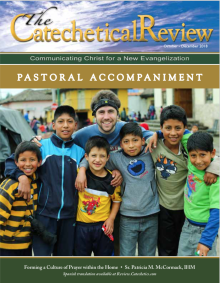What do you remember of your first day of Grade One? My memory gave prophetic purpose and life-long value to my life! After taking roll and assigning seats to her 120 students (not a typographical error!), petite Sister St. Rose announced that our first lesson would be the most important lesson of our lives. She distributed our first catechism book and directed us to lesson one. With pencil in hand, we circled question numbers one, two, and three. Sister instructed us in the meaning of the words and told us to have our parents teach us how to say the words with our eyes closed. My mother proctored homework time. She amazed me when, without looking at the book, she knew the answers to the three questions. More amazing yet was dinner conversation that night. Mom said, “Pat, tell dad what you learned at school today.” I looked my dad straight in the eye and declared with conviction, “I learned why God made me.” Without skipping a beat my father proclaimed, “Pat, God made you to know him, to love him, and to serve him in this world, and to be happy with him forever in the next.” Dad’s reply had an exponential influence because he had justly earned the nickname of “Daddy Old Bad Boy.” Dad’s misbehaviors were legendary and yearly Santa Claus deposited coal in his stocking because of it. So, when this man knew why God made me, I embraced the belief hook, line, and sinker! Echoing the sentiment of Robert Frost1, “that has made all the difference.” Coming to know God—and growing in that knowledge and experience over time—is our universal call, our primary vocation. Knowledge of God and the ways of God leads to love. A person who does not love God does not know God! And whenever any of us love another person we can’t help but overflow into service for them. Prayer: Both Action and Attitude As “First Heralds of the Gospel”2 parents bear the privilege and the responsibility to introduce their children to God; to sensitize them to recognize the ways of God; to learn how to speak to God; to distinguish God’s voice and will from other voices; and to respond to God in age-appropriate ways. Prayer is the common thread for these goals. What is prayer? Definitions abound. Even Wikipedia weighs in on the topic. My core definition, and one that I offer to contemporary parents, comes from that same first grade catechism: “Prayer is the lifting of our minds and hearts to God.” Prayer can be vocal or mental, formal or informal, private or corporate, scheduled or spontaneous. Prayer changes through the ages and stages of one’s life, just as the quality and style of communication changes over time between persons who are growing in relationship. Prayer is communication with the One who knows us better than we know ourselves and Who loves us beyond our ability to comprehend such love. Consistently God communicates God’s love and life-giving will, though we are frequently unaware or inattentive. Often the busyness of life blocks recognition of God’s movements. The noises of our environment drown out the whispers of God’s love. Regardless of our awareness, God continues to speak, to reach out, and to offer friendship. Prayer is both an action and an attitude. Any person, place, stimulus, or event that lifts our minds and hearts to God can be a catalyst of prayer. Spiritual practices that are understood and faithfully embraced raise our spiritual consciousness. Environments, customs, and rituals that tutor the soul or recall God’s presence can stir holy desire and affection.
The rest of this online article is available for current Guild members.
This article is from The Catechetical Review (Online Edition ISSN 2379-6324) and may be copied for catechetical purposes only. It may not be reprinted in another published work without the permission of The Catechetical Review by contacting [email protected]

















